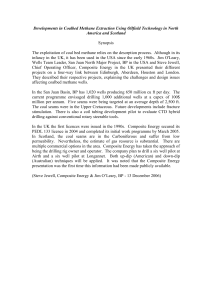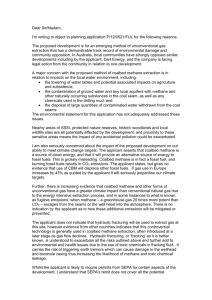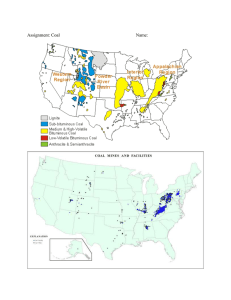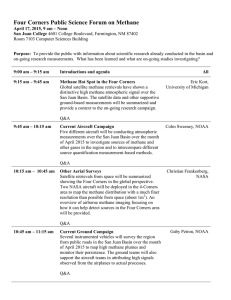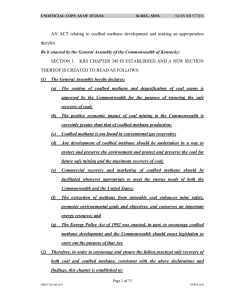Coalbed Methane in the Powder River Basin
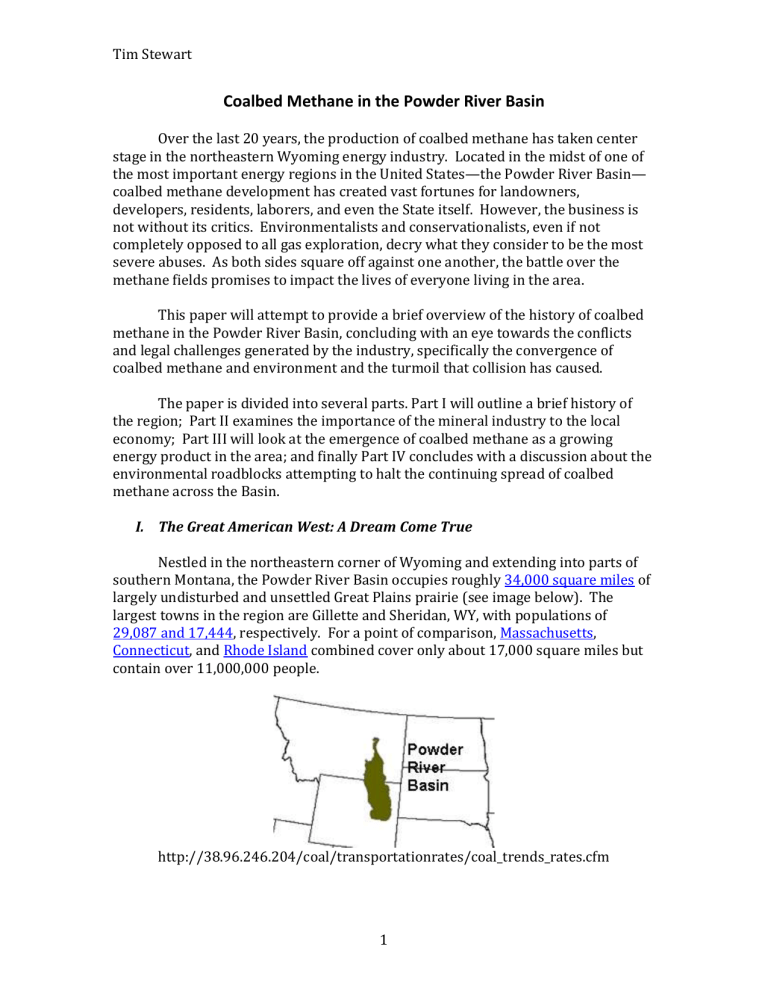
Tim Stewart
Coalbed Methane in the Powder River Basin
Over the last 20 years, the production of coalbed methane has taken center stage in the northeastern Wyoming energy industry. Located in the midst of one of the most important energy regions in the United States—the Powder River Basin— coalbed methane development has created vast fortunes for landowners, developers, residents, laborers, and even the State itself. However, the business is not without its critics. Environmentalists and conservationalists, even if not completely opposed to all gas exploration, decry what they consider to be the most severe abuses. As both sides square off against one another, the battle over the methane fields promises to impact the lives of everyone living in the area.
This paper will attempt to provide a brief overview of the history of coalbed methane in the Powder River Basin, concluding with an eye towards the conflicts and legal challenges generated by the industry, specifically the convergence of coalbed methane and environment and the turmoil that collision has caused.
The paper is divided into several parts. Part I will outline a brief history of the region; Part II examines the importance of the mineral industry to the local economy; Part III will look at the emergence of coalbed methane as a growing energy product in the area; and finally Part IV concludes with a discussion about the environmental roadblocks attempting to halt the continuing spread of coalbed methane across the Basin.
I.
The Great American West: A Dream Come True
Nestled in the northeastern corner of Wyoming and extending into parts of southern Montana, the Powder River Basin occupies roughly 34,000 square miles of largely undisturbed and unsettled Great Plains prairie (see image below). The largest towns in the region are Gillette and Sheridan, WY, with populations of
29,087 and 17,444 , respectively. For a point of comparison, Massachusetts ,
Connecticut , and Rhode Island combined cover only about 17,000 square miles but contain over 11,000,000 people. http://38.96.246.204/coal/transportationrates/coal_trends_rates.cfm
1
Tim Stewart
Although American Indians lived in the region for millennia, settlement of the
Powder River Basin didn’t begin in earnest until the twilight of the 19 th Century. To characterize it as an explosion would be generous. Homesteaders trickled in at a leisurely pace from the across the nation, drawn to the ruggedness of High Plains living for any number of reasons. They came looking for opportunity, a new life, cheap land and open air, solitude, or maybe just to get away from wherever it was they were coming. [is culture part of every energy equation?}
Those early settlers must have been a hardy people, because when they got to the area, they would find a rather difficult life. Hundreds and hundreds of miles from any true population center, those pioneers were forced to scrape together a meager existence out of the harsh and unyielding prairie. About the only thing that was plentiful was grazing land for cattle; everything else came at a price. The land forced people to be independent and self-sufficient, simply because they had no other option if they wanted to survive. And they certainly didn’t get any help from nature. Wyoming is an arid country, prone to drought with wild temperature extremes ranging from over 100 degrees Fahrenheit during the heat of the summer to -20 and below during the depths of winter.
Placed in the middle of such hostile conditions, it is not surprising that
Wyoming and the Powder River Basin remains a sparsely populated region even today. Human civilization consists mostly of scattered ranches dotting the vast countryside between what passes for towns on this side of nowhere.
II.
Minerals, Minerals, Minerals
It didn’t take long for Wyoming settlers to discover that, however mean conditions were on top of the ground, there was a lot of wealth to be found under it.
Starting in 1908, over 2.7 billion barrels of recoverable oil have been discovered in the Powder River Basin alone. The area is a veritable goldmine of hydrocarbons.
The USGS estimates that another 1.5 billion barrels of oil remain undiscovered.
While oil might be the magic word that lights a fire in people’s eyes and sets their pulse racing, the true bread and butter of the region’s mineral machine is oil’s boring brother: coal. The Powder River Basin contains some of the largest coal deposits in the entire world. Wyoming produces about 40% of the nation’s coal, with the bulk of that coming from the Powder River Basin. A single mine in the
Basin—Black Thunder— produces almost as much coal in one year as the entire state of West Virginia. Virtually all mines are surface mines.
Coal might be the big kid on the block, but in addition to all that coal and the oil mentioned earlier, the region also contains at least 2.3 trillion cubic feet of natural gas. With many industry analysts predicting natural gas to be the future of
American energy, Powder River Basin’s gas fields promise to become more and more significant in the coming years. Their development will have a profound affect
2
Tim Stewart on the region’s residents. And to a certain extent, they already have (more about that in a bit).
As would be expected given the coal industry’s prodigious output, mining dominates the Wyoming economy. In 2005, mining accounted for over 30% of
Wyoming’s GDP. The next largest sector, state and local government, contributed less than 10% to the state’s GDP. Mining interests wield extraordinary political power, and many of the residents are extremely proud of the industry. Even if they don’t depend on it for their livelihoods, the business generated by mining contributes greatly to the entire community’s standard of living. The energy sector has been successful at lobbying to create a School of Energy Resources at the
University of Wyoming and regularly donates millions of dollars to a variety of university programs.
Due to the fact that the mineral industry is so ingrained in the local culture, people who would challenge mining’s place in the Powder River Basin face an uphill battle and should be prepared to respond to the public’s fears about the economic impact of interruptions in the mining process. The state is not only energy-friendly but also staunchly conservative. On the flip side there are still many residents who make their living off the land, and in general people in the region have a healthy respect for conservation. Growing up in the midst of a wilderness teaches people to appreciate their natural resources. This duality is readily apparent: not only does
Wyoming power the nation’s coal plants, it also plays home to one of the most spectacular nature preserves in the world—Yellowstone Park.
III.
The Coalbed Methane Shantytown
Up until the 1990s, energy was a force in Powder River Basin life but it hadn’t yet reached the residents’ doorsteps. The coalmines, though large in terms of mine size and output, were insignificant compared to the over 34,000 square miles of open ranch land. Not to say people didn’t worry about the effects of mining on the environment, but in general it wasn’t something that a person would be forced to look at or live around if they didn’t want to. The mines are tucked away behind some rolling hills far outside any town or small community. The main people affected by the mines are the ranchers and property owners directly bordering the mine. Even then the mine tends to own quite a bit of land surrounding actual pit so very few people outside the mine company are exposed the actual operations with any kind of regularity.
That all started to change when coalbed methane arrived on the scene.
Slowly, almost imperceptibly so at first, gas wells began popping up one by one across the countryside. They didn’t stop until they had fundamentally altered the view of the surrounding landscape.
3
Tim Stewart
During the 1990s, a flurry of gas development, driven by high supplies and low prices , raced across the country. In the Powder River Basin, the fever came in the shape of coalbed methane.
Coalbed methane currently provides about 12% of the nation’s natural gas needs, a figure that is on the rise. Like its name implies, the gas comes from underground coal seams, so it is prevalent in areas where there is a lot of coal.
Coalbed methane is an attractive venture in the growing gas market because it has low finding and development costs .
The presence of coalbed methane did not come as much of a surprise to rural
Wyomingites, who had been finding natural gas in their water wells for years. The
USGS knew about the gas as early as 1957 , when it received reports of coalbed methane in flowing artesian wells from coalbed aquifers in the Powder River Basin.
In 1978 the USGS drilled 15 test holes in an attempt to measure the gas content and come to some sort of estimate regarding the gas reserves. From 1981-1992, the first production took place on a small scale among 6 wells in Campbell County, WY.
Starting with just those 6 wells in 1992, the industry exploded over the next decade. By 2002, developers had drilled over 12,000 wells in the Powder River
Basin, with plans to add another 39,000 by 2012 (See Appendix for a map of current well sites). Further development is projected at 50,000 – 120,000 wells over the next 15 to 20 years. Unlike coalmines, which are concentrated and confined to a discreet location, methane fields stretch across extremely vast areas. [is the methane coal being heated by magna?] Although the size of each individual well is small, and a single well does not draw much attention to itself, the combined network of all the wells, service huts, well pads, water reservoirs, access roads, pipelines, compressor sites, drill rigs, tanker trucks, and so on create a gigantic footprint that stamps itself on enormous swaths of land. The area may be desolate, but it isn’t that desolate.
IV.
Everyone’s a Critic
After coalbed methane began to annex the Powder River Basin mile by mile, the residents started taking notice of the mining’s environmental effects. Some of the damage was typical of all natural gas while other was specific to coalbed methane.
As mentioned before, any large natural gas network requires a vast array of infrastructure to support it. Natural gas production is decentralized; hundreds of thousands of individual wells spaced all over the country supply the fuel. [does it have to be this way – what about centralized fracking?] Each well needs a pipeline or some other method of collecting the gas and transporting it where it needs to go.
The wells themselves must be drilled on level ground, which involves clearing a well pad. The companies need to access the wells, so they must build roads to reach them. All the activity physically alters the surface of the land and disrupts habitats.
4
Tim Stewart
Heavy traffic, especially during the early stages of production, on dirt and gravel roads leads to large amounts of noise pollution and dust in the air. These drawbacks lead to citizen challenges of BLM’s Final Environmental Impact Statements during project permitting. [more on how regulation works for coalbed gas?]
One issue has stood out among all others as the lightning rod for environmental activism in the Powder River Basin. A little bird called the sage grouse has experienced an 84% decline in population since the drilling began.
Armed with the knowledge that the activity may result in the extermination of a species, activists succeeded in placing barriers between the drillers and the land.
The BLM has issued protocol designed to protect sage grouse habitats and stabilize populations, and coalbed methane opponents continue to use the sage grouse to block development.
Currently environmentalists are fighting to have sage grouse listed as an endangered species. They have succeeded so far in getting it put on a list of candidates for endangered species protection but no farther than that. A full listing would trigger stronger agency review of and stricter standards for additional projects.
In addition to the rather poignant case of the sage grouse, more mundane environmental problems also have posed substantial obstacles to drillers. Perhaps the biggest and most important is wastewater. Drilling for coalbed methane releases a lot wastewater . The water that comes out can be perfectly clean, safe enough to drink or give to plants and animals. But it can also be nasty, in some cases so extremely bad that the BLM has decided the driller’s only option is to try and inject it back into the well.
Even if the water is clean, it alters the environment. Driller’s are required to collect it in reservoirs to prevent it from washing away all the soil. As mentioned previously, the Powder River Basin has an arid climate. Taking water out of the ground and making artificial ponds has a big impact on an ecosystem that isn’t used to so much moisture. In one of the more bizarre twists to the continuing saga, researched linked a portion of the sage grouse decline to the possible spread of
West Nile virus among the birds due to increased breeding grounds for mosquitoes.
V.
Conclusion
If readers only take away one thing from the story of coalbed methane in the
Powder River Basin, then they should remember the incredible speed at which the drilling took off once it became profitable. By the time it started, it was too huge to stop. Activists who want to affect meaningful change should always try to introduce reasonable, workable solutions as early along in the project as possible. Inertia builds once the wells start producing and the money starts to flow. When that happens, the development takes on a life of its own. No one should underestimate the scale at which these things grow.
5
Tim Stewart
Appendix http://www.gastar.com/globaloperations.cfm?pagesect=powderriverbasin
The lined area with the highest concentration of wells is Campbell County,
WY. Campbell County contains some of the largest coalmines in the country, such as
Black Thunder. It has been called “the energy capital of the nation,” because over
30% of United States coal comes from this single county.
6
